Artemia breed, keep, propagate & feed - Everything you need to know about Artemia
If you have been looking back on your successful aquarium for some time, you may sooner or later succumb to the temptation to reproduce your fish. But perhaps they have already done so all by themselves with more or less good success. Even if we in the Google age already think to know everything, there is nevertheless a small thing with the fish breeding, which we lose more frequently times from the eyes and from which the cellar children two generations before us could sing us a song: the perfect fish raising fodder! (A fish farmer friend of mine, when asked what he would do if he knew he had only 12 hours to live, gave the succinct answer: "Prepare Artemia!") And once we are "in" with our skin and hair, in this cycle of feeding baby fish and mixing salt water, his answer will make us smile.
What's the best thing that can happen to a fish? LIFE FOOD! there the mouse does not bite off a thread. Artemia nauplii may be known to some as fairy crayfish from the Yps magazine and all these years their fascination has not been lost and for many, including me, they became the very first guinea pig before an aquarium was even thought of. In the meantime, there are even experimentation kits specially put together for children, with which they can dare to try out the living object directly after trying to grow salt crystals
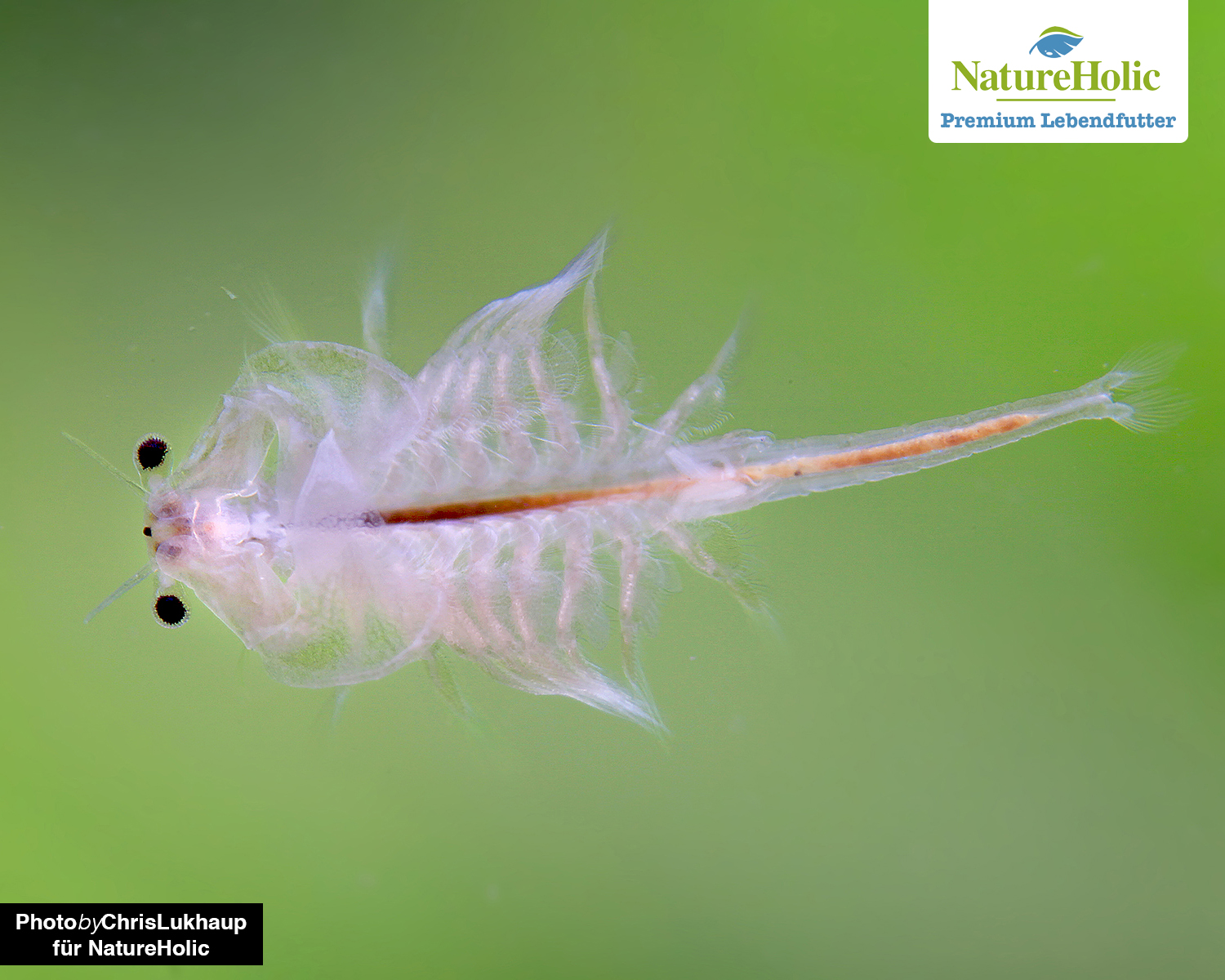
First food for fish larvae
When given a choice, fish, still virtually invisible and perhaps the size of a floating comma, prefer live and nutritious food as their first food. Most baby fish feed on their yolk sac after hatching from the egg and, loosely speaking, hang lazily for the first few days almost motionless on the substrate, aquarium glass or plants until they swim up to the water surface for the first time and fill their air bladder. From this point on, they feed on their own - so our job as new fish parents is to make sure that the rascals get something decent in their stomachs, so that they grow healthy and stay healthy and don't develop deformities. Most fish do not yet have the necessary enzymes for digestion and are therefore dependent on the enzymes of the food animals. Even if some adult fish are later full-time vegetarians, but especially the youngest need high-quality animal proteins to become a full-grown veggie. It is not for nothing that successful fish farming is also called the "secret of the professionals". And here you will learn a little background knowledge about the Artemia hype.
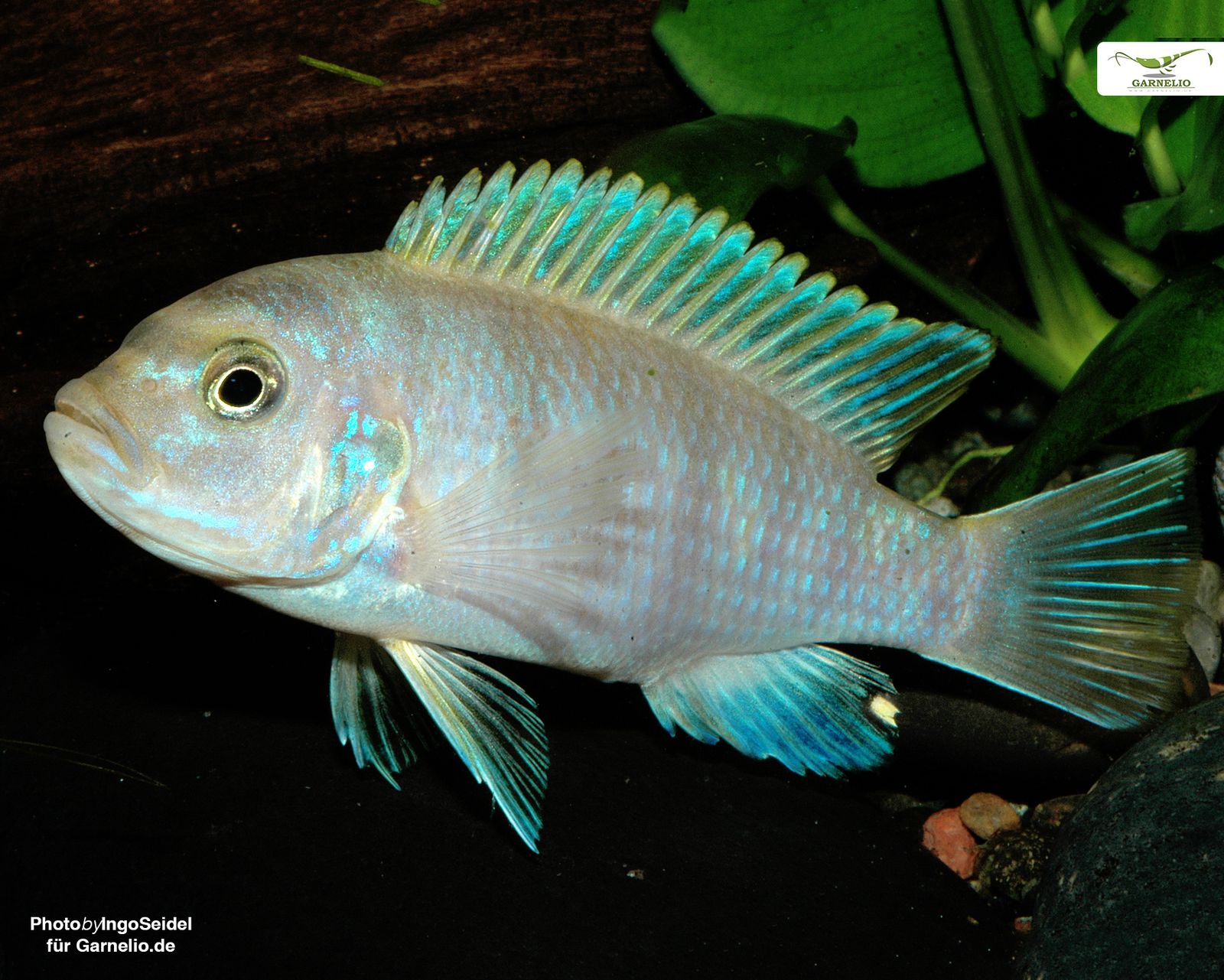
Breeding Artemia yourself
Artemia products for do-it-yourself and for feeding are now available like sand on the beach, so that one can quickly lose the overview and be overwhelmed by the selection. What is it all about and do you really need it? Let's take a quick look at a few search results:
Decapsulated Artemia Eggs
this refers to Artemia eggs that no longer have a hard eggshell. This is removed with a chlorine solution and vinegar, then rinsed and dried again. For quick feeding these eggs, which contain even more nutrients than nauplii that had to put their energy into hatching, are quite practical - for example, if you have accidentally lost sight of your own Artemia batch, for time reasons or to feed the maximum nutritional content. However, decapsulated Artemia eggs should be soaked in aquarium water before feeding, otherwise they will swell up in the fish stomach - and we don't want to give our pets a stomach ache. The only disadvantage: the fed eggs move only once - and that from top to bottom, when they fall into the aquarium. Most rearing aquariums do not have a large current, so that the hunting reflex of the young animals is mostly absent. And the stomach empty. Therefore, it is more suitable as a menu change for fish that are already familiar with canned food. Alternatively, decapsulated cysts can also be hatched. The advantage here is that you can save the separation and hatch the remaining eggs after the first "harvest" in a second run. Also with artemia cysts there are sloths, which simply sleep one round longer than their siblings.
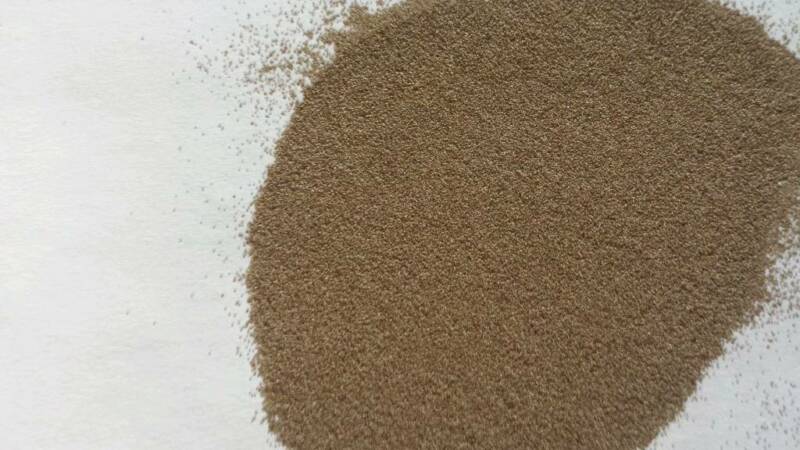
Artemia rearing tray / the UFO
This refers to a special construction from Dohse, in which the nauplii hatch in a darkened tray with a separating grid in salt water and, since nauplii react extremely to light sources, swim to the bright center over a sieve, which can then simply be removed for feeding. The egg shells remain in the tray. The whole thing works without additional aeration because the large surface area allows sufficient oxygen exchange. This type is practical if you run your aquarium in the living room and do not want to be distracted from your series by the air pump and water bubbling or always need only a small amount of live food
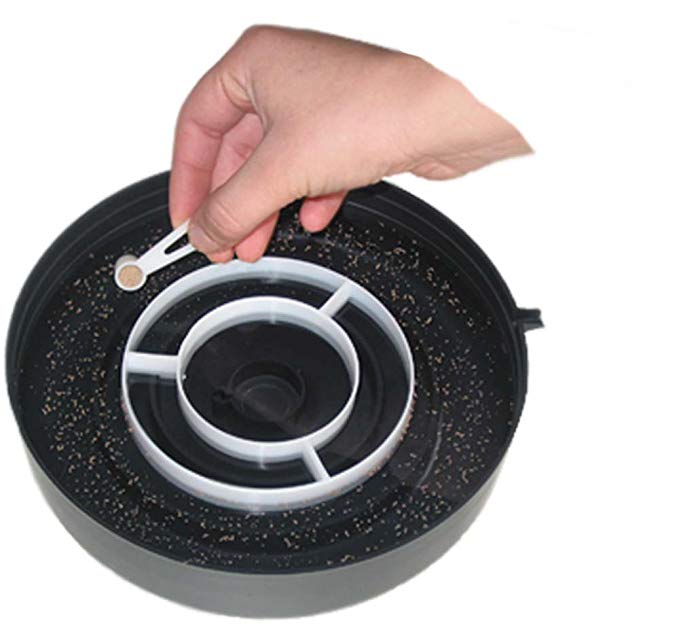
Egg and salt mixture
This mixture is already premixed and consists of Artemia eggs and a salt mixture, which also already contains micronized phytoplankton, which serves as initial food for the brine shrimp.
Liquizell/ ArtemioFluid/ Microcell/ Protogen
If you want to raise Artemia nauplii to real brine shrimp, you need a special food, because it is this issue that leads to most problems during rearing. Since nauplii have only developed rudimentary mouthparts from the 2nd-3rd day, they also require food in a very tiny size. Microcell is atomized phytoplankton in powder form, liquicell is liquefied microcell which keeps the tiny particles in suspension. From day 3, nauplii can be fed with Liquizell droplets, and from day 8-10 with microcell. Feeding is done only in such minimal amounts until the water shows a very slight green turbidity. Since the amount of food depends on the amount of nauplii and the size of the tank, it is difficult to give a dosage - but less is more. Tip: Microcell can be dosed and fed with a toothpick or a knitting needle!
Protogen are concentrated and dried infusoria in different sizes, such as ciliates, paramecia, slipper, eye and ciliates, which are on a nutrient substrate. Infusoria are also called infusorial animals because they come to life when water is poured on them. Infusoria are even smaller than Artemia nauplii and are therefore perfect as initial food for hatched fish larvae. These are given 5-10 grains in the aquarium, the amount is doubled the day after. Infusoria are fed until the young fish are large enough to eat nauplii. However, infusoria can also be grown in plastic or glass dishes as a pre-culture and fed with a pipette. By the way: Infusoria are also great for shrimps and other invertebrates! Especially for snail breeders Protogen is a recipe for success.artemioFluid is a liquid food for nauplii consisting of ultra-fine homogenized phytoplankton, similar to Liquizell, and is also very suitable as initial food.
JBL Artemia Set with Hatchery / Dohse Incubator
This set is probably the most frequently used in aquaristics and probably also the most popular. Therefore, everything here also revolves around this type of live food make yourself. The set contains a stand, a conical funnel (the incubator) with a round lid, an oxygen pump with an air hose, and a sieve with a collecting container: the perfect start for successful nauplii breeding! If you want to be on the safe side, you can install a check valve between the air pump and the incubator. At the bottom of the incubator is a drain valve that separates the shells from the eggs. The set is very easy to assemble and maintain. There is no need for cumbersome shell separation. JBL also offers the pre-mixed egg-salt mixture, which you only have to fill up with water. However, mixtures from other manufacturers work just as well. The wall mount and built-in pins on the base are also practical, and you can easily hang another incubator on them. In this case, the lids are connected together so you can run both incubators with the same air pump.in the Dohse incubator, eggs, salt and water are placed in a conical bottle with a stopper and turned upside down. At the bottom of the bottle is a drain valve which, during incubation, acts as an air valve. After hatching, the bottle is turned the right way around again and placed at a slight angle. When draining the nauplii, the egg shells remain attached to the inner wall of the bottle. The nauplii can be transferred directly to a separate rearing tank developed by Dohse, which is equipped with an air lifter that creates a coarse water movement to increase oxygen input and keep food in suspension
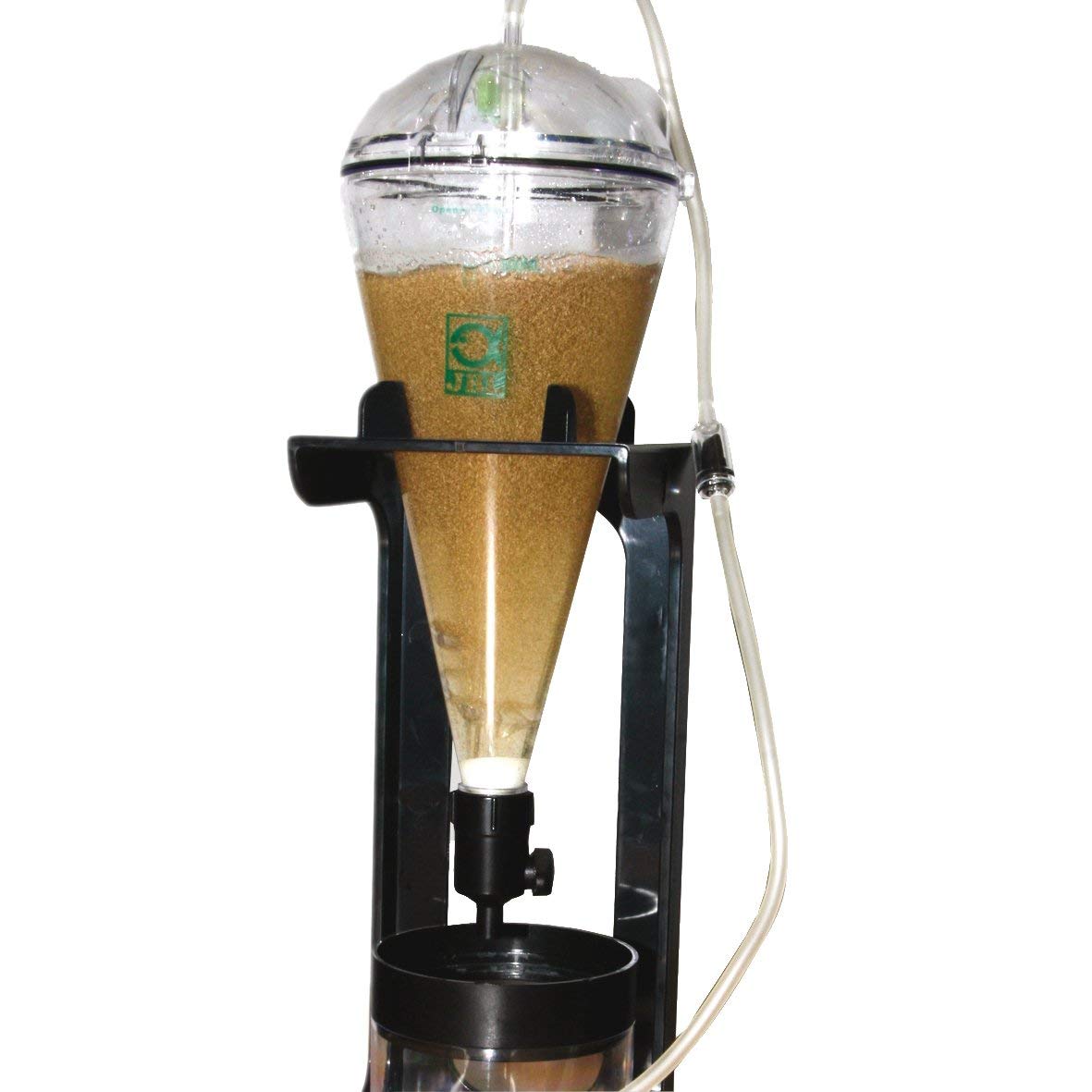
Live food vs. frozen food/ freeze-dried live food
not all live food is the same, as there is a world of difference between home-bought and home-made. Although nowadays most live food cultures can be more or less kept and propagated by oneself, this is sometimes associated with effort or odors and does not always meet with the approval of the two-legged co-inhabitants at home. The trade now offers a wide range of live foods such as red, black and white mosquito larvae, Tubifex, Cyclops, Artemia, Dapnia and many others. These are in small pouches with a nutrient solution that keeps them alive. Unfortunately, when you buy these sachets, it is not clear how long the food animals have been in them and how their quality turns out, because they are swimming not only in a vitamin solution with preservatives, but also in their own excrement and "fallen comrades". This food is not "bad" per se, if you have thoroughly eyed it before buying and agree with yourself that the majority of the creepy-crawlies still look fit and vital. Nevertheless, they should be sieved and pre-rinsed with an Artemia or tea strainer before feeding, so that no impurities or bacteria are introduced into the aquarium. The sieve combinations from JBL, which have different mesh sizes, are also very suitable for this purpose.
Storage of live food
If possible, purchased live food should only be bought from refrigerators, transported in a cool place and also stored in the refrigerator at home and fed promptly. Live food usually triggers the hunting reflex in fish, even the very smallest and even the most domesticated high breeders. However, it may happen that the favorite guppy is simply a foodie who has no appetite for Tubifex at the moment, but prefers midges. Depending on the fish species, the possible live foods also differ to some extent: various perches, for example, react extremely sensitively to red midges, which can lead to digestive problems and even death of the fish
Frozen food
Frozen food is an alternative. These are offered in large or small plates to break off, as well as in "chocolate bars", where you can remove portions of food and thaw them. A very big drawback with frozen food, however, is the uncertainty of the cold chain. Frozen food should also be frozen after shock freezing at the manufacturer's, transported home frozen if possible and still kept in the freezer compartment.
FROZEN FOOD
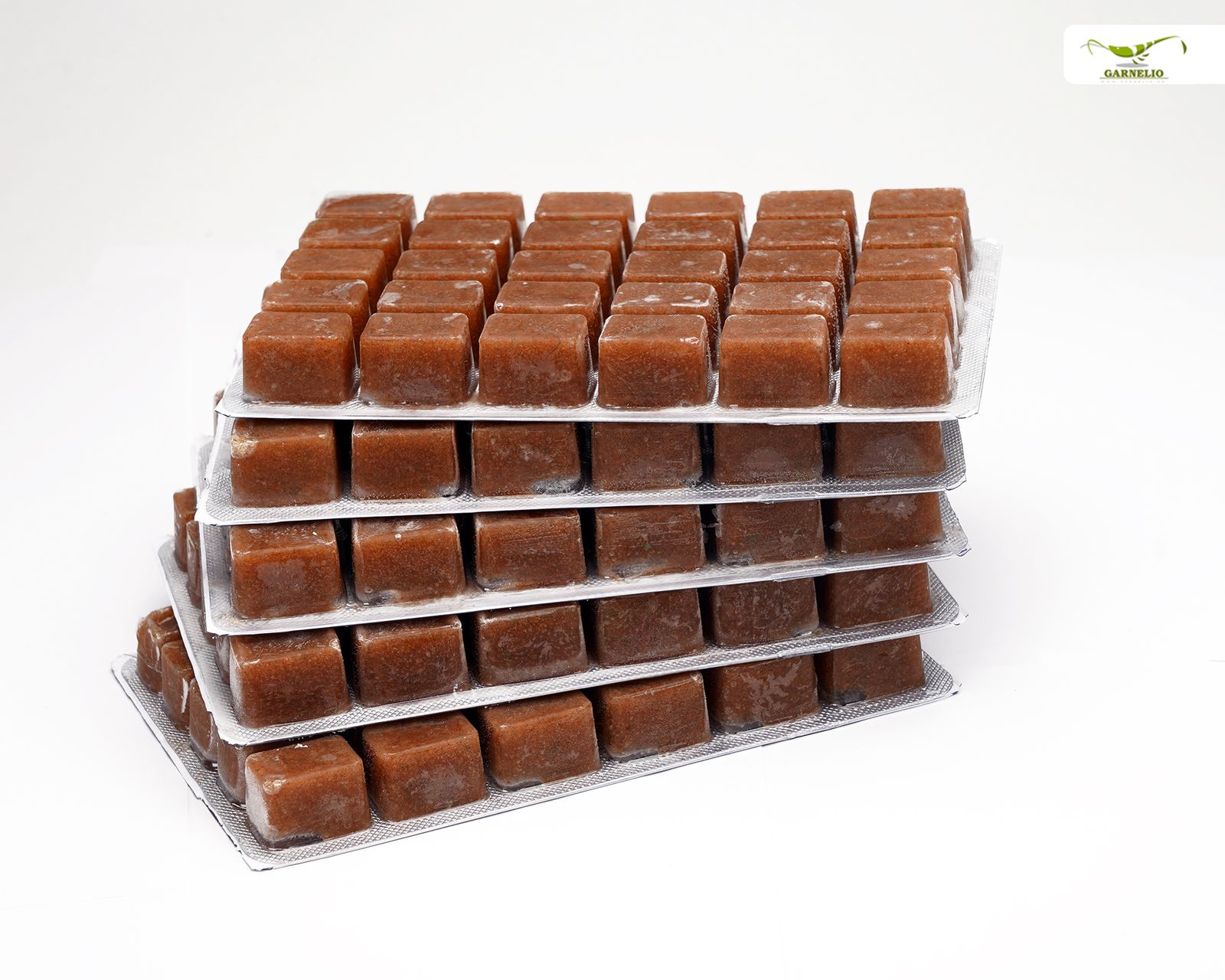
However, since no one can say with certainty whether the frozen food has not been defrosted or thawed on its long journey to the home freezer next to pizza and Cornetto, it should also be examined critically when purchased: if water crystals have formed on the visible side of the individual portions, it is better to refrain from buying, since once defrosted or thawed food can spoil or is already spoiled. Perfect frozen food does not show these water accumulations, because the adhering water is still in and around the food animals and could not "drip off" by thawing and collect.
Feeding frozen food
Frozen food is thawed in portions and rinsed and or enriched with vitamins before feeding. JBL Atvitol is ideal for this purpose. Frozen food should never be fed as "ice cubes", as fish can get digestive problems from the ice-cold food animals. On the other hand, this introduces too many bacteria and by-products into the aquarium, which can sometimes severely disturb the water environment. Especially red mosquito larvae must be specially bred and have on average many substances that are more than unfavorable in the aquarium. Also, red mosquito larvae can cause problems for allergy sufferers who handle them with their bare hands; a polypeptide sequence in the hemoglobin of red mosquito larvae can lead to asthma , urticaria and Quincke's edema, among other problems.
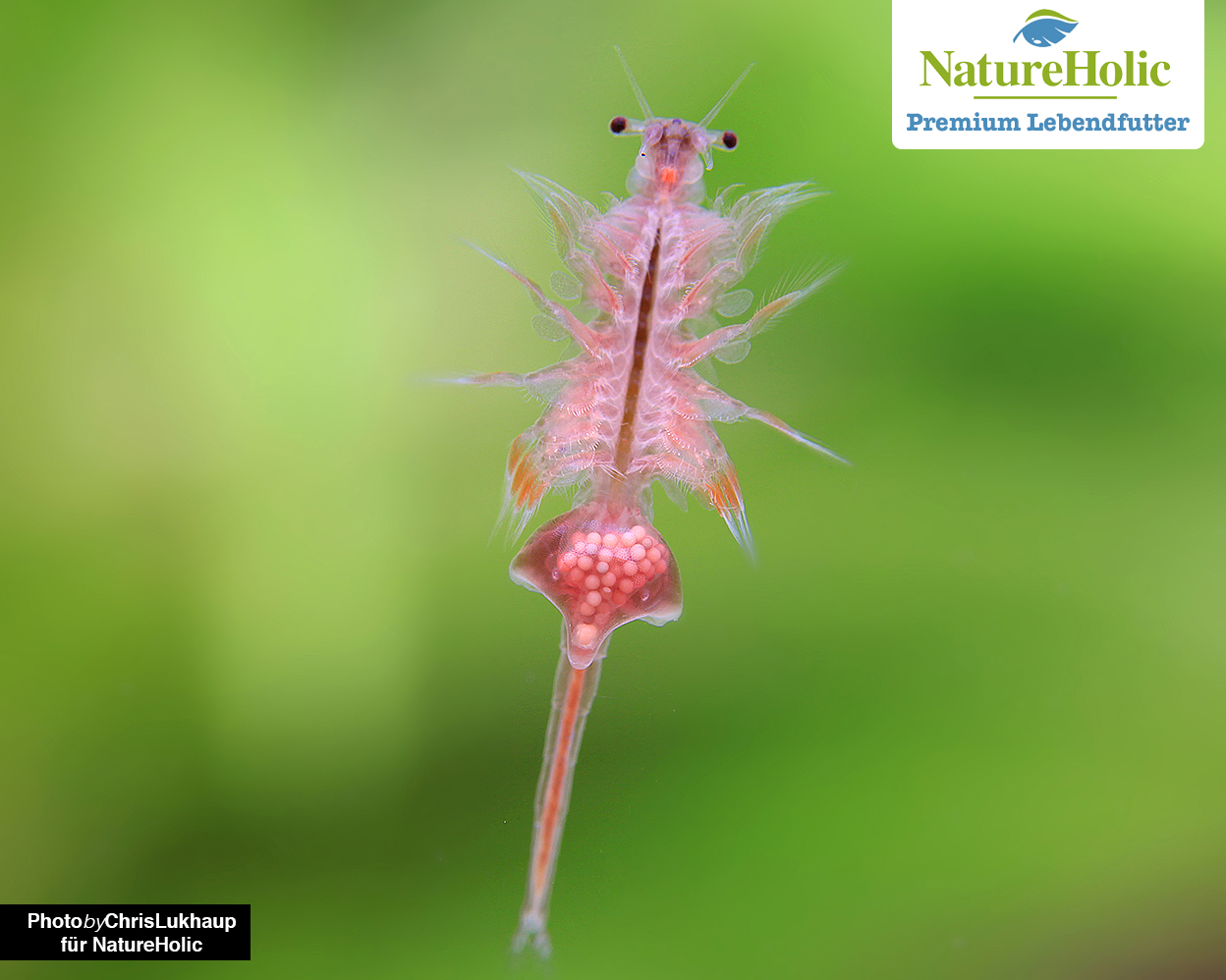
Freeze-dried food
Freeze-dried live food has a very high quality, because all nutrients are still contained in the feed animals. The feed animals, such as daphnia, mosquito larvae, artemia, copepods such as Cyclops Eeze or others are shock-frozen and dried at very low temperatures, but also partly gently sun-dried. Accordingly, this treatment also has an effect on the price, which, however, can be easily forgiven in view of the uniquely good quality. The disadvantage of freeze-dried food is, however, that the reflexes of the living food animal are missing and especially in wild-caught fish do not trigger the hunting reflex, because the dry animals float on the water surface. However, these snipeers can be animated to eat if the feed animals are presoaked in aquarium water outside the aquarium and given directly into the current with a pipette.
Cultivate" live food yourself
Cultivating live food yourself is therefore an optimal solution that is independent of seasons and store closing times, and allows you to answer the most important questions yourself. The cultivation and live food use of Artemia found more and more followers mainly in the '70s. Especially the user-friendly innovations of the probably best-known hobbyist Hans Dohse, whose passion for Artemia nauplii made him tinker and experiment for years, now allow the permanent cultivation and permanent availability of Artemia and nauplii in all growth stages - and that without studying microbiology or nuclear physics!
Artemia - fascinating small crustaceans from a time before ours
Artemia salina are gill-feet, i.e. monotonous small crustaceans without dorsal carapace and extremities and the best known representatives of all prehistoric crustaceans in the order of the copepods - the Anostraca. In total there are 7 species and one subspecies. They are found worldwide in salty waters, brine lakes and salt ponds such as inland lakes, where the brine shrimp filter phytoplankton from the water with their 22 leaf feet and at the same time supply themselves with oxygen. They usually swim with their bellies upwards and move the collected food towards their mouths, where it is crushed and eaten. They do not distinguish between usable and unusable food - but we will come back to that.
Artemia can grow up to 2 cm when fully grown and live for a few months. Their growth depends on their environment, the salinity, as well as the food supply. However, they also search the substrate for food and crawl "the right way around" through the sand.
Habitats of Artemia and occurrence in nature
Artemia are found in saline waters, where the salinity is so high that there is limited to no other life that can become a predator for them. The traded Artemia salina originate mainly from San Francisco Bay and Salt Lake in Utah. When caught, Artemia deposits are contained with floating barriers, siphoned, cleaned and preserved. However, trapping bans are also in place for sustainability, as 5-20% of permanent eggs are used for species and population conservation, according to the U.S. government
Even though they are the best known of all primeval crayfish species, Artemia salina are not the most common, so that further populations exist worldwide, with the exception of Antarctica. From some of them a hybrid species (e.g. Artemia nyos) was bred out in the 1950s, partly explicitly for the toy trade and research, but so far it has not gained any recognition. Nyos refers to the "New York Ocean Science" Laboratories, which markets these Artemia as so-called "Sea Monkeys". This species behaves exactly like Artemia salina and thanks to its behavior of collecting all floating objects in the water, small glittering stones are sold to match Artemia nyos, which are supposed to make the Artemia nyos swim around through the water and give the impression of floating diamonds
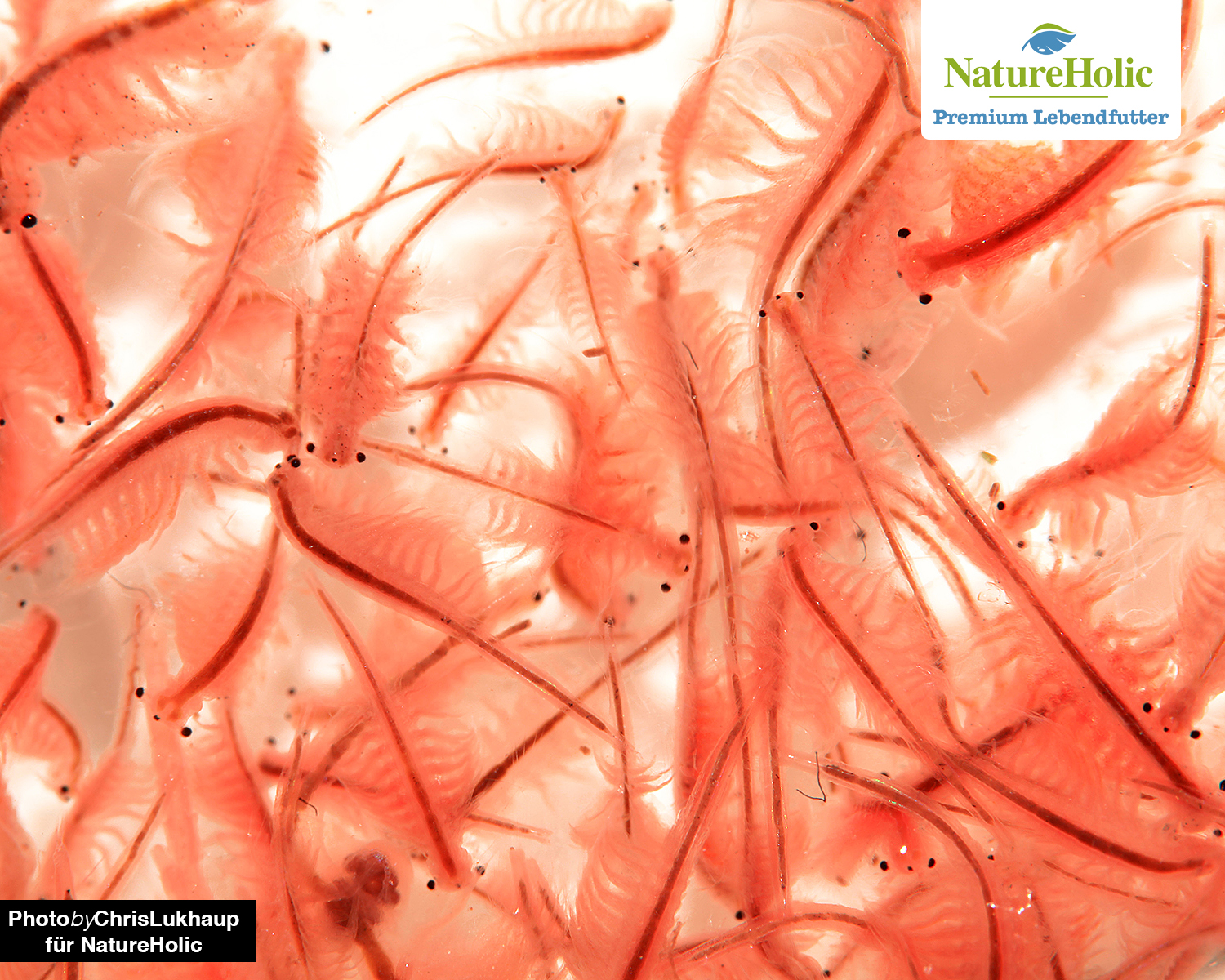
How long have Artemia been around?
Artemia have been around for over 100 million years, originating in freshwater. Artemia can also be found in freshwater, for example the fairy crab, but it is now a protected species. At present, 500 finding areas are officially known, further occurrences are so far kept under lock and key.
Growth and development
Artemia are sexually mature at about 14 days of age and have shed their skin about 20 times by then. When fully grown, they have three eyes, two pairs of antennae, 11 trunk segments and 8 abdominal segments with a tail fork. Their mandibles convert to chewing and feeding tools, and in males also to styli. Females can even fertilize themselves thanks to their hermaphrodite gland. They have a brood sac by which they can be recognized, males transform the mandibles of the second pair of antennae into grasping organs with which they hold the female.
Reproduction
During mating, the male clutches the female and, clinging to each other, fertilizes her for days. Artemia can form both permanent eggs, called cysts, which are multicellular and without their own digestive system and sometimes hatch decades later, but also live young that have formed only a very thin egg shell and, depending on the environment, hatch from the brood sac of the female in just under 5 days with 100 siblings. When salinity levels rise and their habitat dries out, Artemia lay permanent eggs that can survive periods of drought. This ability has also preserved the species of primeval crabs.
Adapted to extreme biotopes
Artemia are also very interesting animals in other respects: they are even able to excrete excess salt from the water they ingest via their terminal appendages, the so-called furca, and thus regulate their osmotic balance. However, if the salt content continues to rise, oxygen uptake also becomes more difficult, which they compensate for by increasing their hemoglobin content. In order to regulate the ion content of their hemolymph to the increased salt content, the crustaceans consume almost one third of their energy budget. In doing so, they radiate a strong red-orange color (which is also caused by reddish algae that they have ingested).
This ability allows them to survive in sometimes 70% salt water, where they have no other swimming predators to fear, as these are not able to survive there. The only exception, however, is flamingos, which have colored feathers thanks to the nutritious live food. The permanent eggs of brine shrimp are also true survivors and are sometimes transferred by waterfowl to other waters. Interestingly, however, Artemia do not occur in waters, although suitable for their species, that are avoided by waterfowl. Artemia could theoretically survive in seawater, but here they find themselves as the main course at the buffet of marine fish and corals, so that their population would be wiped out in a very short time.
The miracle of life
Artemia nauplii depend primarily on salinity, proper water and temperature to hatch reasonably. With a commercially available egg/salt mixture, you simply add water according to instructions, make sure the ambient temperature is correct, and the first nauplii will hatch after 24-48 hours.
The cysts absorb up to twice their size in water, awakening the embryo from its "dormant" state and allowing it to develop. Head first, the nauplii hatches from the ruptured egg membrane and is still inside a membrane attached to it. Within a few hours, the hatching membrane is penetrated by water to such an extent that it also ruptures and detaches from the embryo together with the egg membrane. The nauplius now swims freely and slowly forms digestive organs, mouth and anus. Depending on the environment, it sheds its skin for the first time after half a day, which costs it a lot of energy. Therefore, it is advisable to feed nauplii before the first molt, as their nutrient content is highest then and they will otherwise consume it themselves.

Salt
however, if you want to do everything yourself, a three to four percent salt concentration is recommended. Without the addition of salt, unfortunately, nauplii breeding does not work at all. Salt concentrations above this reduce the hatching rate and sometimes even increase the mortality rate. Recommended here are commercially available sea salts, or the Artemia salts already enriched with phytoplankton. Although experiments have shown that even dishwasher salt has led to hatching results (road salt, by the way, has not), these nauplii should be used rather less as fish food. Common household salt, with or without iodine, also works. The correct dosage here is 30-35 g salt per liter of water. (Although nauplii tolerate fluctuating densities reasonably well, the evaporated water in the rearing tank should not be topped up abruptly, but distributed over days. Artemia can survive in up to 7% salt water when all other life has already disappeared. This characteristic has also ensured their survival for thousands of years.
Eggs
theoretically, the amount of eggs added is irrelevant, however, it should be remembered that a 500 ml hatchery tank can also hatch a huge amount of nauplii, which should be fed promptly. Hatched nauplii can be stored in saltwater in the refrigerator, but they shed their skin for the first time 12 hours after hatching, which means that they consume a lot of energy - their nutrient requirement therefore decreases again. Also, with mega-quantities the chance of higher mortality is increased, because the nauplii have an increased oxygen demand and also many excretions put additional strain on the water, so it can tip over. Therefore, to feed truly fresh and nutritious nauplii, it is worthwhile to purchase a second hatchery tank timed so that a batch of live food is ready every 24 hours. With an egg-salt mixture, the ratio of salt to eggs is balanced so that a normal portion of live food is hatched.also with Artemia eggs there are different qualities and offers in the trade, whose efficiency is to be recognized above all also in the price. With rather inferior varieties almost twice the amount of eggs is needed to get a halfway decent portion of live food, with very high quality products almost only half. Currently, however, you can find manageable supplies in stores where you can select for yourself: the highest hatch rate and quality are Artemia eggs from San Francisco Bay and Salt Lake in Utah. For ordinary hobbyists, who only want to raise their young fish or give their animals a little variety in their diet, this is of little importance, as the eggs offered by e.g. Hobby or JBL are completely suitable for this purpose. Breeders who calculate their daily requirement of nauplii in kilos are well advised to use petifool. Even though Artemia cysts have an almost eternal shelf life, they must be stored appropriately after opening: the eggs should be vacuumed again when not in use, or at least frozen in an airtight container. This is also particularly suitable when buying a larger quantity that will not be hatched in the foreseeable future. Storage at room temperature and oxygen can result in a 10% hatching loss per year.
Temperature
Usually nauplii hatch in a time window of 24-48 hours at a temperature between 25° and 30°C. However, this ambient temperature is difficult to keep constant - therefore it should be noted that nauplii can also be bred at a cozy 19° C room temperature and below - sometimes a question of time, but this also allows outdoor keeping - because nauplii hatch even at frosty 4°C! Sometimes some eggs need a little longer, so that after 24 hours you can sieve the first batch of nauplii from a single batch, switch on the incubator again and "harvest" the meanwhile hatched rest another 24 hours later. Hans Dohse does not suspect a lack of quality in this behavior, but simply the same phenomenon as with chicken eggs: some egg shells simply have more starch than others. However, a batch should not be run for longer than 48 hours, as egg shells, dead nauplii and excretions have a negative effect on the water quality and no live nauplii can be expected afterwards anyway, as they react sensitively to contamination.
Water
There are also many opinions about the optimal water for the preparation. Some swear by boiled and stale tap water, others swear by rain or spring water and the clever ones do not make any compromises and use the osmosis water of their system directly, because their aquariums run with it anyway. If you follow the instructions on the packaging of Artemia kits, tap water is supposedly sufficient. However, it is disregarded here that the water values vary greatly throughout Germany, are different in winter than in summer and in spring not the same as in autumn and that tap water is sometimes enriched with chlorine and phosphates for disinfection of drinking water pipes. So I leave it to the reader how he wants to deal with the fact that he prepares the tap water for his aquariums with special water conditioners, which should protect his fish and invertebrates from just mentioned toxins and heavy metals, but wants to use just the same tap water for breeding invertebrate Artemia nauplii. Water treatment for nauplii breeding would also be recommended here, which is associated with effort for regular approaches. You can certainly knit this topic with a hot needle and consider how many heavy metals are in the groundwater or whether rainwater was collected via a smogged house roof by copper gutters - all of which is also not expedient. The safest solution is probably actually deionized water, be it from an osmosis plant or simply: distilled ironing water! A 5 liter canister for just under 2€ is sufficient for 10 approaches with the JBL breeding tank.
The correct approach to nauplii production is, as always, divided. Every fish breeder you ask has his own method and his own secret, so you can assume that many roads lead to Rome, or to the nauplii. In the end, the way you hatch your live food depends on your own experiences and your preferred handling. However, in order to familiarize yourself with the subject and to achieve initial success, it is worthwhile to resort to the commercially available premixes and to use them according to instructions.
Live food enhancement - boosting nauplii
With regard to the perfect composition of a perfect fish food, scholars argue to this day. And if it is then still a Aufzuchtfutter, anyway. Fortunately, Artemia nauplii do not care about such discussions and have the miraculous talent to consist of this seemingly perfect composition of protein, fat and carbohydrates. It is undisputed that the nutritional value of nauplii is highest immediately after hatching - of course they can still be fed beyond that time! However, it is important to remember that the hatched brine shrimp feeds on its yolk sac for the first 1.5-2 days after hatching, which is the secret ingredient in Artemia power food. After this metamorphosis, the nauplius still has proteins and fats - and the nutrients that it has eaten itself in the meantime.
Nutrient content of Artemia nauplii
Even if the nutrients of Artemia nauplii, or of Artemia vary depending on origin, age and development, one can still orientate oneself approximately to these guideline values:
Protein 50%, fat 20%, crude fiber 2%, crude ash (indigestible) 6%, water 8%.
With this nutrient ratio, Artemia nauplii are particularly suitable as a starter and power food. Since nauplii wriggle and are not exactly the fastest distance swimmers, they stimulate the innate hunting instinct of fish larvae on the one hand, and are also quite easy for them to catch. Even in fresh water nauplii live for a few hours, so it is not a problem if you see almost no fish babies because of all the nauplii - because they munch their way through the buffet in the next few hours. However, it is more advantageous to feed the young fish 3-5 times a day with smaller portions, which unfortunately might be difficult to realize for most working people.
NATUREHOLIC PICTURE
Boosting nauplii
As already mentioned, a nauplii does not differentiate between digestible and indigestible substances it ingests. This property can be used effectively to give the fry or adults an extra dose of vitamins, nutrients and medications. If nauplii are left to swim in a solution of the desired substances from the moment they start eating, they absorb them and automatically transport them to the fish body when fed. The great advantage of this is that the water in the rearing tank is not contaminated, but on the other hand it is also possible to treat a fish specifically with medication by placing it separately and feeding it with the prepared nauplii.
Adding vitamins and important fatty acids
I discovered this technique a few years ago in a book for successful clownfish breeding in marine aquariums and have been using it for some time in freshwater aquariums as well. Mainly I add vitamins to the nauplii, JBL offers a multivitamin complex with Atvitol, which is perfectly suitable for this purpose, I also achieve a higher proportion of useful fatty acids in combination with "LipoVit" from the company Tropic Marin. Also the combination of multivitamin juice with conventional omega-3 supplements for human consumption are reasonably suitable, but the handling is awkward, sticky and not everyone wants to drink his Tetra Pak Multi every day (although it might be advisable) - besides, JBL Atvitol is suitable for other purposes, so the vitamin bottle actually belongs in every aquarist's hand box anyway.
Enrichment in two variants
I currently practice two variants of enrichment: in the first variant, the nauplii are sieved off immediately after hatching and placed in a glass dish in a moist mist. A few drops of JBL Atvitol are dribbled onto them and then kept in the refrigerator for 4 hours, after which they are fed. The background of this method is diffusion, with the help of which the nauplii absorb the nutrients. The second variation is to continue to aerate the nauplii beyond the hatching time, and about 36 hours after that, put them in a small glass or petri dish with some of their salt water and drip the nutrient solution into this. I again let these feed in the refrigerator for four hours, then rinse them off and feed them. If I place the nauplii to be enriched at the exact time of the hatching fish larvae, both the nauplii are old enough to eat nutrients and my baby fish, which I have previously fed with infusoria or microworms, are nearly large enough to handle the nauplii. Thus, they receive all the necessary nutrients for their start in life to become wonderfully pretty and colorful little fish that grow sensibly and optimally together and do not run the risk of dying off for some unknown reason.
JBL Atvitol can also do more than just enrich nauplii! I even use the vitamin to occasionally "feed" the aquarium water with it. Especially the useful microorganisms and purification bacteria in the aquarium get an extra "boost" and improve their performance and reproduction. It is also suitable for enhancing frozen food and the usual canned food, but with this variant a lot of it dissolves again in the water, so that only a little reaches the fish belly.
Breeding and keeping: Avoiding mistakes when rearing Artemia
Food
Although hatching nauplii is quite easy, the breeding and keeping of Artemia can be a bit difficult and sometimes needs several attempts and perseverance.the most common mistake is in feeding. Nauplii form their mouthparts and digestive organs in the first three days and feed on their yolk sac until then. Added food, and usually considerably too much at that, will cause the water to tip shortly after feeding. It is recommended to feed the nauplii from the third day after hatching with just enough drops of Liquizell or ArtemioFluid until the water shows a faint green coloration. Feed again only when the nauplii have "cleared" this coloration. The liquid feed can be given up to the 12th day, but theoretically also permanently; Liquizell also has a quasi eternal shelf life. After that, it is possible to switch to microcell. Feeding should also be sparse here, a toothpick or knitting needle tip provides dosing assistance
Aeration
While nauplii thrive particularly well with high aeration, Artemia should rather be kept in a small number with only weak aeration in a relatively large vessel (recommended from 10 liters). The nauplii moult very often depending on their stage - these exuviae also pollute the water, as do their excretions.
Microflora in the Artemia aquarium
As in an aquarium, a microbiology with bacteria is formed, which must first develop. If bacteria are added, they can counteract the breakdown of waste products. An Artemia tank can also be inoculated with the usual water conditioners and bacteria preparations! Weak aeration is used to keep food particles in suspension: Artemia are not sprinters and therefore tend to collect their food slowly. Alternatively, the water can be stirred daily. A substrate is not a must and turns out to be rather disadvantageous especially when cleaning the tank
Lighting
The Artemia tank should receive daylight, but no direct sunlight (among other things, overheating leads to water evaporation and thus a lower oxygen content with a simultaneous increase in density). Small clay shards at the bottom serve among other things for the settlement of algae, which serve as food for the Artemia. If these accumulate sufficiently by themselves, additional feeding is not necessary for months.
Cover
The tank should be covered, because dust can hinder the swimming legs of the Artemia, with which they take in food and oxygen. A corner should be left free, so that a gas exchange can take place.
Water change
A water change is only necessary for Artemia if the water is very polluted. Since the separation of Artemia and contaminants is complicated, it is worthwhile to mix new salt water, let it react for 24 hours and then transfer the crayfish. This is best done by luring them to a corner with a flashlight and sifting or netting them out. Evaporated water is replenished with unsalted water; for larger quantities, these losses should be compensated for over a period of days.
artemia in permanent culture
Artemia only live for a few months. With good care, however, they always release live young and also sufficient permanent eggs, so that the stock is maintained. If, on the other hand, the entire rearing tank is allowed to dry out, the density increases, which in turn signals the end of the spawning period to Artemia and stimulates the formation of permanent eggs. If you pour the dried up batch again at some point, nauplii hatch again and the whole cycle starts all over again.
Tips and tricks - Breeder tube cleaning made easy
And suddenly it happened: life got in the way again, the fish are already knocking impatiently with their fins on the aquarium pane and then your eyes fall on the Artemia breeder... The still aerated broth is blithely turning in circles and the once reddish promising load of freshly hatched Artemia nauplii has turned into a transparent something, with a sticky eggshell edge just before the lid closure. Eyes closed and through! The incubator can be cleaned quickly with a few hand movements and a bottle brush, but the air tube, once stuck inside, sometimes brings beads of sweat to your forehead. Simply holding it under water doesn't work, nor does blowing through it.
For a while, I have also struggled again and again and was on the verge of replacing the tubes completely, until a roll of craft wire fell into my hands. I decided to insert it into the tubes and move it back and forth under running water. In the twinkling of an eye the air tubes were cleaned and immediately ready for use again - but above all the air flow was again as effective as at the beginning of the Artemia hatchery.
Although the hungry mouths now had to wait another day for fresh food, but for such cases there is fortunately still a microworm culture in the house, which forgives a momentary ignorance.

<!--[if gte mso 9]><!--[if gte mso 9]> Normal 0 21 false false false EN X-NONE X-NONE <!--[if gte mso 9]> <!--[if gte mso 10]>
Outdoor keeping and breeding of Artemia
In contrast to the conventional methods of hatching Artemia only in the hatcher, the possibility of outdoor husbandry and propagation is particularly suitable. Especially if you have to care for several aquariums and several young animals, but also wild-caught and rather fussy candidates, outdoor breeding is particularly suitable.
Suitable for this purpose are, for example, mortar t ubs and tubs from the hardware store, but quite pragmatic aquarists have also simply put a disused bathtub in the garden and prepared accordingly impermeable to water. However, Artemia cannot be bred in infinite numbers in the smallest space, so that here a "more" in tub size also produces a "more" in food animals, alternatively one simply uses several culture tubs. With a little bamboo netting you can, if necessary, disguise the rather questionable looking tubs or tubs in the front garden or on the balcony, so that they almost look like small mini-ponds - which they are in the end - above all, a little decoration can defuse the possibly threatening discussion with the head of the house. J
The most important thing in outdoor Artemia breeding is the location- because the tubs work without technology. Therefore, a location should be chosen that has sunlight for as long as possible, because this is necessary so that sufficient algae form in the breeding tubs, which are eaten by the Artemia as food.
Once the ideal location has been found, the tubs are filled with water. In principle, it does not matter much which water is used, so collected rainwater is also suitable. On rainy days, but also on very warm sunny days, the water level will change again and again - almost like in the habitat of the Artemia, so that they cope relatively well with change and fluctuations. The water is now salinated, whereby fluorine- and iodine-free commercial table salt, but also sea salt for aquaristics can be used. Personally I prefer the last variant. About 2.5 kilos of salt are now used for 60 liters of water. Likewise, this can be " inoculated " directly with dry baker's yeast and with chlorella or spirulina in dust form, so that enough algae form as quickly as possible and the Artemia grow vigorously and quickly and multiply. One week of patience should be invested, however, so that the salt water reacts and the algae have had enough time to reach an appropriate mass. During this time, the bucket should be stirred once a day if possible.
After the week of patience, the bucket can now be stocked either directly with Artemia eggs, or alternatively with a freshly hatched batch from the hatchery or with ready-made live food bags from the pet store. Depending on temperature, weather and location, it can take up to 14 days before the nauplii hatch. An average temperature of 20 °C has proven to be ideal. After the hatching of the cysts, the tank should be stirred well once a day, so that settled food particles dissolve again and are available to the Artemia. Feeding can be done additionally with algae powder, but also with very finely ground fish food, whereas powdered algae have proven most effective.
In general, the outdoor Artemia breeders can withstand temperatures from below freezing to above 40 °C.
A landing net is the best way to fish the Artemia from the water surface, and the "harvest" is most abundant in full sunlight, as Artemia have an affinity for light. Also in the tub the Artemia multiply almost constantly. During the warm summer months into the fall, new young hatch constantly. Towards autumn, permanent eggs are laid, which survive the winter months and come to life again the next spring. Even a small layer of ice does not affect the bucket, but with a floating piece of wood, the freezing can be prevented to some extent. An alternative to outdoor overwintering can also be to move the tubs into the basement, here the tubs should probably not freeze over. With an aquarium heater it would even be possible to keep the breeding going permanently.
If the water level drops tremendously due to evaporation, fresh water can be added to the bucket, but this should be done in stages over a few days. The salt that was originally added will still be in the bucket, albeit in a very concentrated form, so there is no need to add new. Even if the entire bucket dries out, the increasing salt concentration will cause the Artemia to lay permanent eggs, which will then be at the bottom and hatch when it is re-filled with water.
The outdoor breeding of Artemia is an extremely money-saving affair, since the animals are not only permanently available fresh in highest quality, likewise constantly new beginnings, which make under circumstances the enterprise of an air pump necessary, as well as the acquisition of Artemia cysts are saved. In addition, the tub culture can be maintained almost all year round.
By the way, experience has shown that growing your own Artemia cultures with Artemia franciscana is particularly suitable, as they are quite resistant to fluctuations and therefore cope well with the climate in our latitudes. Especially the use of several tubs is worthwhile, because they can be fished alternately, so that always enough offspring can develop. If a breeding is conspicuous by a large mass of adult animals, but hardly any juveniles can be discovered, the number of adult animals is possibly already too large, so that the nauplii are decimated within the species. Therefore, a remedy may be generous fishing, which in turn stimulates the remaining adults to reproduce.

produktiver Beitrag
Hallo,
ein äußerst informativer und darüberhinaus auch kurzweilig zu lesender Beitrag! Man erkennt, dass es dem Verfasser (auch sprachlich) Freude bereitet, sein Wissen zu vermitteln. Ich werde jetzt in die Artemia Grossproduktion einsteigen.
Grüße
Danke für die tollen Infos
Dieser sehr informative Artikel hat uns nun auch dazu ermutigt unser eigenes Lebendfutter zu produzieren. Und ganz nebenbei ist es bestimmt sehr spannend die Entwicklung der kleinen Urzeitkrevse zu beobachten.
Super
Sehr informativer Beitrag
Macht Lust, dass Ganze selber auszuprobieren.....von Anfang bis zum Ende, welches sich hoffentlich Zeit lässt.....:)